Where to go in Switzerland on a short trip: Alps, lakes, and cities
Switzerland is an extremely popular country for those planning multi-stop tours around Europe, yet very few potential first-time visitors actually know specifically where they want to go. Everyone seems to know that it has the most beautiful views of the Alps and some very impressive cities, but there are actually many misconceptions among casual trip planners, so I’d like to clear most of that up below. The places to visit in Switzerland are not obvious until you’ve been there yourself or done many hours of research, so the list below should be a short cut.
I get hundreds if not thousands of itinerary questions for people who are considering a Eurail trip around Europe, and most people just include the word “Switzerland” among a list of cities like Paris, Rome, and Berlin that they want to visit. So where in Switzerland should you go if you can only make a few stops at most? I’ll answer that question below. You’ll mostly want to focus on the best choices for Swiss Alps trips, which I’ll go over below.
Note: This article was expanded and updated in February, 2024.
Switzerland is about outdoor views rather than city visits
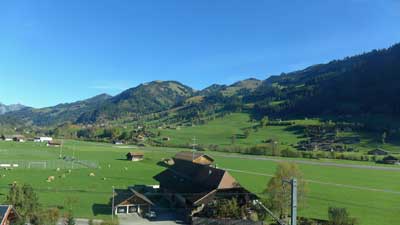
Geneva is a very famous city (though not for tourism reasons) on a lovely lake of the same name, but it’s also notoriously dull and lacking distinction. Rick Steves puts it well by saying that “Geneva is pleasantly situated on a lake, like Buffalo or Cleveland.” The point is, you don’t want to go to Geneva unless you’ve got something specific in mind that you want to see there. There are much better places to visit in Switzerland if your time is limited, or even if it’s not.
Switzerland's cities in summary
Zurich – The largest city, very expensive, geared towards business travelers. It’s generally a pretty and very well-run city that you would enjoy if you visited, but it’s not nearly as interesting as the likes of Vienna, Munich, or of course Paris.
Geneva – Second largest city, in the French part of the country, no major sights. Again, if you visited you’d be very impressed by it and get some great photos, but it’s not worth your time unless you know someone there. There’s an impressive fountain in the lake and you can usually see it from the train as you go through the city, but it’s not really worth going there and staying more than an hour or so.
Basel – Bordering France and Germany, no major sights. It has the famous art market each year, and aside from that it’s even duller than the ones above. Again, if you visited you’d be impressed, but if you later compared photos with friends who went to the Lauterbrunnen Valley instead, you’d kick yourself for going to Basel.
Lausanne – Near Geneva in the French part of the country, very hilly, and certainly more interesting than Geneva.
Bern – The capital, compact, on a lovely river, some interesting sights and the best Swiss city to get a feel for the culture. Bern is fairly close to Interlaken (which we will discuss below) and it can be a great day trip from there, especially on a day where it is foggy and/or rainy in the mountains (and this happens a LOT).
How much time and which Swiss cities to visit?
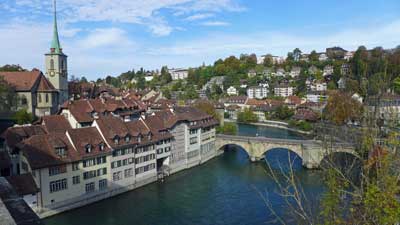
Many people (me included) don’t feel as if they’ve scratched the surface of a new country if they haven’t spent at least a day or two in the largest city. Zurich is certainly pleasant and a useful transit hub so spending one or two nights there wouldn’t be a major mistake. But Zurich isn’t even close to being a city like Paris, Rome, Berlin, Amsterdam, or even Vienna. If you skip it in favor of spending more time in the Swiss Alps, you won’t be missing much.
The 2 Best places to visit in Switzerland for short visits
Interlaken – If you want the best possible Alpine views and activities, head to the Interlaken area, which will be described in detail below. This is my favorite of all places to visit in Switzerland and it will probably be yours as well.
Lucerne – The traditional Swiss tourist retreat, Lucerne is a small city with interesting culture and sights, that is gorgeously set on a lake with plenty of top activities surrounding it.
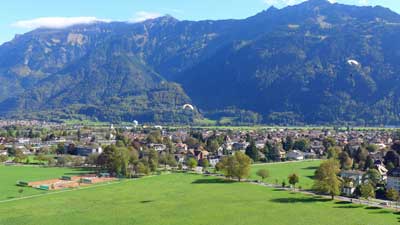
>>>Interlaken and Lucerne: Which to choose and how long to stay in each?
The article linked above will give you more details on which to choose and how long to spend in each place.
What about Zermatt for Alpine views?
Zermatt is a remote car-free village in southern Switzerland that is famous for being the place to see the Matterhorn mountain. It’s also a busy ski resort area, and aside from that, there isn’t much to see or do here. It’s on a private rail line, so it’s more complicated and usually more expensive to reach than Interlaken.
In other words, unless you’ve irrationally placed “Seeing the Matterhorn in person” on your so-called bucket list, skip Zermatt and head to Interlaken on a shorter visit. You won’t be sorry. If you already have enough time in your visit for the main sights around Interlaken and Lucerne and you want to also see the Matterhorn, then by all means go and you’ll enjoy it. There are quite a few other car-free villages in the Lauterbrunnen Valley near Interlaken, so they are not as novel in Switzerland as one might expect.
A weekend in Switzerland? What to see in 3 days
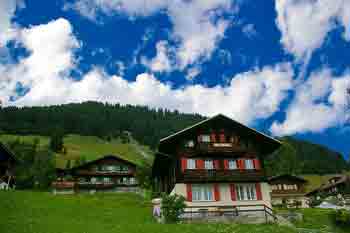
One challenge is that neither has an international airport so you’ll either be flying into Zurich or perhaps Geneva.
Train times from Zurich to Lucerne to Interlaken and back
- Zurich Airport to Lucerne: 1 hour 10 minutes by train
- Lucerne to Interlaken: 2 hours by train
- Interlaken to Zurich Airport: 2 hours 15 minutes by train
As you can see with the travel times above, Zurich Airport to Lucerne is a fairly short trip, but once you add Interlaken into the mix (even if you skip Lucerne) the travel time starts to add up for a weekend visit. With this in mind it’s probably best to just choose one of them and save the other one for another trip.
Lucerne is gorgeous, but the Lauterbrunnen Valley near Interlaken is really the star of the show, so I’d recommend going there first and doing Lucerne on another trip.
What about the Swiss Travel Pass?

The bottom line is that if you are coming to Switzerland for at least 3 days and you want to take 2 or more of the amazing scenic rail journeys that the country is famous for, the travel pass is probably a good deal. It also provides 50% discounts on the Schilthorn cable car and 25% off the Jungfraujoch mountain railway. Both of those are quite expensive on their own, but extremely worthwhile, so the discount is helpful.
The Half Fare Card is probably a better deal for most people
The Swiss Travel Pass is a good deal for those who are going to be spending at least 2 or 3 days riding the rails and seeing Switzerland that way. But if you are mostly going to be focusing on Interlaken and Lucerne and the mountain sights, the Half Fare Card is the best option. For CHF120 (about US$134) you get the card that is good for 30 days and gives you a 50% discount on all trains, cable cars, mountain railways, and other sights and attractions. If you are doing either Schilthorn or Jungfraujoch, the Half Fare Card practically pays for itself with just one of those.
>>>Buy the Swiss Half Fare Card
Many people have questions about the Swiss Half Fare Card so I will explain it a bit here. You can actually buy half price train tickets for travel within Switzerland any time you want and you will see that option when you go to buy them online. The only thing is you have to have and present a valid Half Fare Card when you get on the train and are asked to see your ticket. In other words, you can buy a half fare train ticket today and buy a Half Fare Card just before you get on that train months in the future, and you are fine.
How and why visit the area around Interlaken
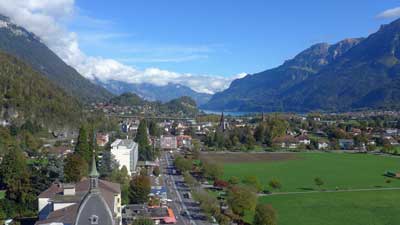
You can see everything discussed below by actually staying in a hotel in Interlaken, but it’s not the Alpine experience that you get if you stay in one of the small villages nearby. You can reach those villages in 20 to 40 minutes from the Interlaken Ost (East) train station, and it’s much easier than it sounds.
The 3 best places to stay to visit the Swiss Alps
Lauterbrunnen – A private train line runs from Interlaken Ost station to the end of its line in Lauterbrunnen. There’s a lovely waterfall here and great hiking trails, but you should probably only stay here if you can’t get to one of the villages mentioned just below. It’s a great little transit hub and it’s definitely gorgeous, so it can be worth a night if you’ve got one to spare.
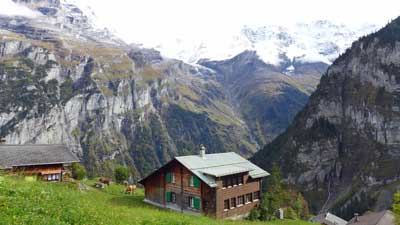
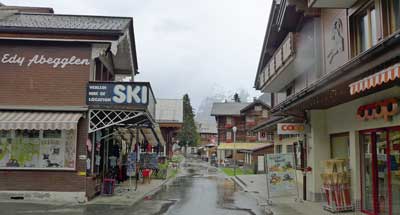
Where to stay in Interlaken and the Lauterbrunnen Valley (with pics)
I get so many questions about where to stay in the Interlaken area that I decided to write a longer version of it and load it with huge photos so readers can get a better feel for each option. I also included recommendations for affordable and well-located photos in each area.
>>>Where to stay in Interlaken and the Lauterbrunnen Valley New for 2024!
The unforgettable things to see here (if the weather is decent)
Schilthorn observation deck and restaurant
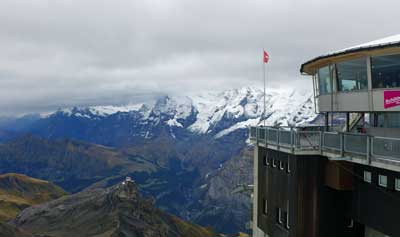
There is a rotating restaurant (with prices similar to normal Swiss restaurants) and a bizarre and anachronistic James Bond attraction based on it being a key location in the 1969 movie On Her Majesty’s Secret Service. The Bond thing is included with the lift, and it’s worth a look.
But the main thing you come here for is the 360-degree view from one of the highest peaks in Europe. Again, the weather here is key, but fortunately all the locals track the visibility on a minute-by-minute basis. If it’s clear up top while you are in the area, it would be a terrible shame to skip it based on the high price. But even if it’s cloudy up top, there are still plenty of wonderful things to see and do in the villages below.
Jungfraujoch observation area
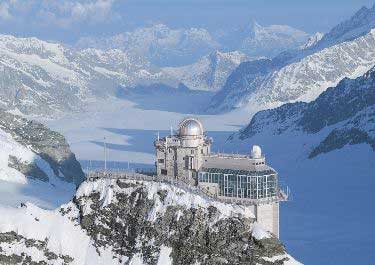
The views from the top are similar to the views from Schilthorn, from the other side of the Lauterbrunnen Valley. Once on top you can have lunch, hike, or even go sledding. It’s also quite expensive at nearly US$200 round-trip unless you have a Swiss Pass or a Eurail Pass for discounts, and it takes most of your day, but you’ll never forget the views from the top.
Harder Kulm mountain and Two Lakes Bridge Observation Deck
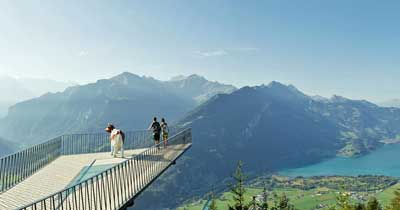
There’s a revolving restaurant about 10 minutes’ walk from the station at the top, which is definitely an unforgettable place for lunch if you’ve got time. It’s not as expensive as you might expect, at least compared to normal restaurants in Switzerland.
The Harder Kulm Railway goes from early April through late November each year. If you are only in Interlaken for one day and/or you are on a strict budget, this is the fastest and best way to get amazing Alpine views in the area.
Getting from Interlaken to Gimmelwald and Mürren
Getting up to these villages sounds complicated and time consuming, but it’s actually fast and easy once you get there. This little guide should help.
Arrive in Interlaken
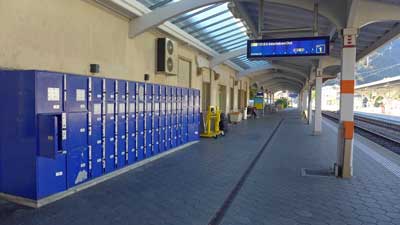
Once you arrive at the Interlaken Ost train station, head for the ticket windows in the office and buy a ticket to your final destination (Lauterbrunnen, Gimmelwald, or Mürren). Eurail passes are good for 25% discounts on the rest of the trip, but not for the whole thing.
From Interlaken Ost to Lauterbrunnen
The private train leaves Interlaken Ost every 30 minutes and arrives in Lauterbrunnen 20 minutes later. If you are staying in Lauterbrunnen then you are probably walking distance from your hotel when you reach the station.
From Lauterbrunnen to Gimmelwald
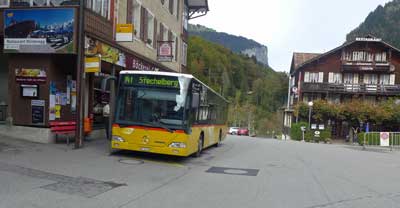

From
Gimmelwald to Mürren
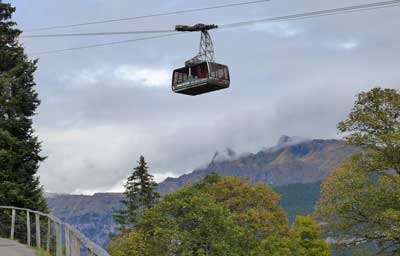
Recommended hotel and hostel in Gimmelwald
I get asked all the time about where to stay in Gimmelwald, so here it is:
Hotel: Esther’s Guesthouse
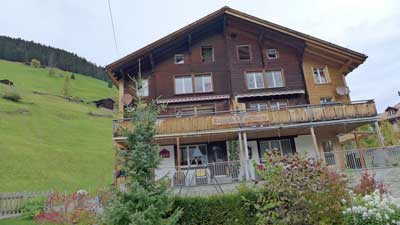
It’s run by Esther, as you might guess, and she is very friendly speaking excellent English. Each room is different and the place feels like a mountain cabin, because it is. She offers an excellent buffet breakfast in the morning, which you have to order the night before. It’s not cheap, but it’s worth it because it’s hearty and there are no other good options nearby.
Book as early as possible because this place is often the first place to sell out in Gimmelwald.
Hostel: Mountain Hostel Gimmelwald
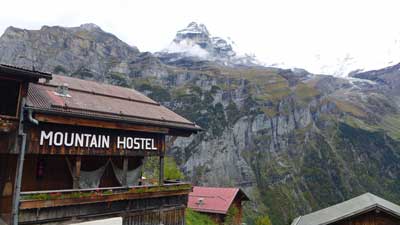
You won’t believe the views from this place, which are the same as from Esther’s except a bit lower and more unobstructed. This place also has a busy bar and restaurant that is basically the only “nightlife” in Gimmelwald. Many hikers get to bed early in this tiny village, but if you want to have a couple drinks and order a pizza or some local options, this is the place to go.
Again, book early because this place is always sold out.
Lucerne and what to do there
Luzern, as it’s spelled locally, is the other traditional holiday destination in Switzerland. Unlike Interlaken, Lucerne actually qualifies as a small city rather than a small resort town, so it’s a very nice contrast and very worthwhile. We have a new article with advice on where to stay in Lucerne and it should be helpful.
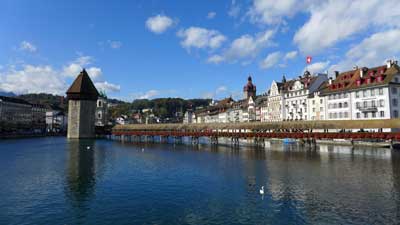
However, unlike Interlaken, the town of Lucerne itself is a great attraction and worth at least a day of exploration. This has always been a rich area so you can expect to find all of the high-end shops and boutiques along the small streets just north of the lake, but there are also many traditional shops and things to see that will appeal to anyone.
Recommended hotel in Lucerne
>>Hotel Des Alpes (3 stars with an amazing location and view)

If this place is booked, which is often the case, then book a hotel as close to it as you can find or afford. The whole historic part of town surrounding it is lovely, with restaurants, bars, and high-end shops. There are also a couple of nearby supermarkets where you can buy inexpensive alcohol and picnic supplies to keep other costs down.
Spend a day in Lucerne itself
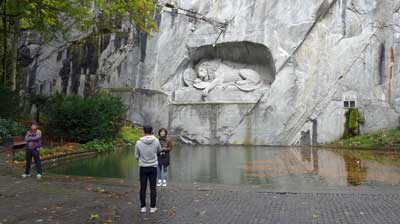
Most of the interesting part of Lucerne is in the area behind those restaurants, and it’s certainly worth doing a self-guided walking tour if not a guided one. Heading farther east you’ll come to another older part of town where the famous lion statue is located. You can’t visit Lucerne without having a look at the lion, and fortunately it’s easy and quick to reach (and it’s free).
Take a lake cruise of some kind
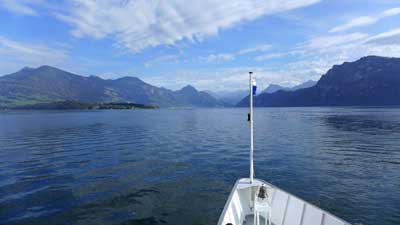
Especially in nice weather, even the short lake tour is lovely, and if you have more time you can jump off at Vitznau and do the scenic hike up Mount Rigi. There are also small lakeside villages that are ideal for a stroll and lunch stop. Long story short, there are dozens of interesting sightseeing options that are available using part of the boat tour, and the views all around are wonderful.
Visit Mount Pilatus
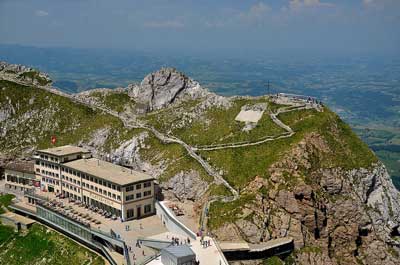
You can take the cogwheel train up and have a more or less flat hike around the summit area, and then take the gondola and cable car back down again. You can do them in the other order, and the cost is the same either way. At around US$65, this is not a cheap hike, but like most everything in Switzerland, the quality is high so it doesn’t feel like a rip-off. You can reach the cable car in 10 minutes on a public trolly bus from Lucerne.
Visit Mount Rigi
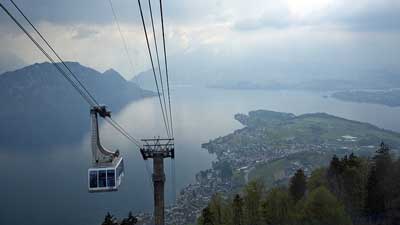
Unlike the other peaks mentioned in this article the Swiss Travel Pass covers both ways to get up and down for free. The others are 50% off with the Swiss Travel Pass or Half Fare Card, except for Jungfraujoch, which is only 25% off with the Swiss Travel Pass and still 50% off with the Half Fare Card.
Visit Mount Titlis
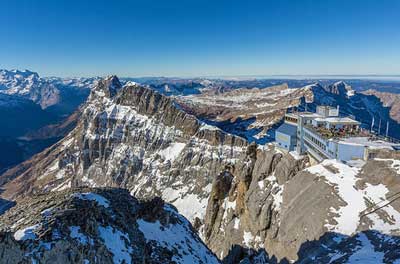
You can reach Titlis by taking a 43-minute train ride from Lucerne to Engelburg and then taking the cable car up from there. As with the others, it’s wise to check the weather immediately before you are going to depart because it can be foggy or cloudy any time of the year, but usually not for whole days at a time.
Additional photo credits
Jungfraujoch by cupweuro on Flickr, Pilatus by Tony Fernandez on Flickr, Rigi by Kosala Bandara on Flickr, Titlis by PaulSchliebs on Flickr

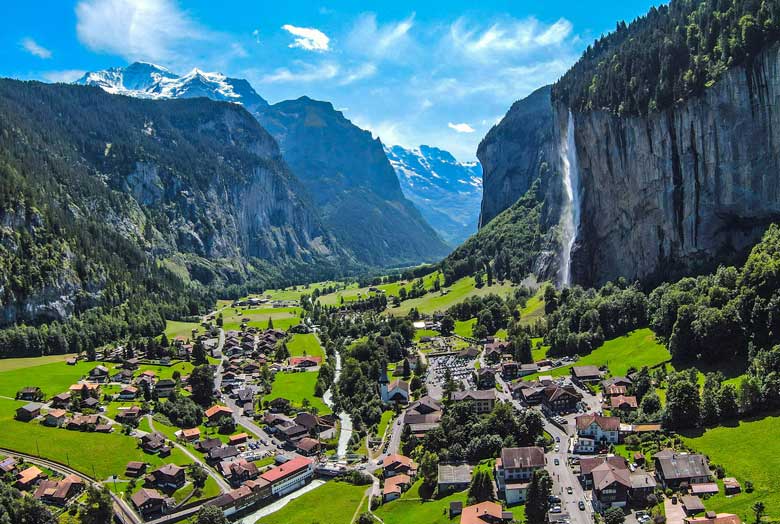
Hi Roger, I think you may have missed my last post above. Here it is again, if you are able to answer:
Ah, thanks! I knew SBB ran the trains but didn’t think to check there for the cable cables. That will make things easier to look up!
OK, thanks for the comments. I do appreciate it. You’ve been very helpful – we’ll certainly plan to head to Murren and walk down to Gimmelwald, and I think the train on the other side of the valley as you suggested is a great way to see things. Yes, I’ve seen some pics of the surroundings and they’re certainly remarkable. Not hard to see why you recommend it. As for a trip up another peak we’ll play that my ear. I’ll check out some more pics, work out my preference, then see how things go when we’re there.
One last thing if I may – are you very familiar with Lugano? It looks a nice place and we may even try for one last drive up into the mountains from there before we leave. Anyway, we have to head from there to MXP. Do you have any idea of the best way to get from Lugano to MXP? When I search for tickets on SBB we have a change at Mendrisio but only 8 min to make that change. If we miss the change (quite possible since we’re not familiar with the station/trains, etc) the next train is 2 hours. So if we’re going via train we would have to leave 2 hours earlier to cater for that possibility. I am wondering if there is a bus or something we should catch instead?… Thanks
Chris,
Sorry I missed your earlier questions and I’m happy to try to help. I’ve only been through Lugano and I haven’t spent any time there. It is quite a lovely city that will be a change of pace from your other Switzerland stops. This is an interesting conundrum. The Mendrisio train station seems to only have 6 platforms and it should take no more than 2 or 3 minutes to get from any one of them to any other of them. You just walk down the stairs into the tunnel and then walk up the stairs of the platform of your next train. And with small stations like this it’s very common that the trains would be on the same platform or just across from it, so there’s a good chance that it will literally be a 10-second walk.
Also, the Swiss trains are famously punctual, and most of them arrive and depart exactly on time. Since this would be a train starting in Switzerland and then changing to another train still in Switzerland, you should be totally fine. However, Italian trains are famously casual about their schedule, so if this was a train leaving MXP and heading into Switzerland it could easily depart 10 or 15 minutes late. I’m not aware of any buses although there may be one. Long story short, if SBB.CH recommends this connection (and 8 minutes is more than enough time) I think I would trust it. That said, missing a flight is a big deal so I might also hesitate to gamble. I hope you can figure something out. -Roger
Thanks Roger
We are going in Winter from Jan 6 2019 – Jan 9 2019 so we will follow your advice and do the Lake Cruise once we arrive in Lucerne. How much is this usually and is this included in the Swiss Pass? I am hoping we do not miss out much on not going to Mount Rigi given we are going to Mount Schilthorn (we could arrive earlier in Lucerne but that would require us taking an earlier flight and waking up at 3:30am in Amsterdam rather than 6:00am)
We will probably book the Goldenline scenic train on the way to Murren as we are passing by Interlaken on the way there anyway. We can book this on the http://www.sbb.ch website correct? The initial Lucerne – Murren route I scoped out via IR, R, LB, R trains had the Lucerne – Interlaken leg on the IR 2916 departing 8:06am via the “LUZERN-INTERLAKEN EXPRESS”.
We will also follow your recommendations with Lauterbrunnen, Wengen and perhaps Bern if the weather suits. I take all the transport costs are included in the Swiss Pass however if we were to book them individually – how much roughly would it cost per leg? We are weighing the benefits of getting a a Swiss Pass vs using a portion of the Eurail pass to cover our travel.
Thank you again.
Philip,
Yes, the Swiss Travel Pass fully covers the boat trips on Lake Lucerne. There are different departures throughout the day, with some being longer than others. You’ll have to check the schedule for when you’ll be there. I imagine the winter schedule is less busy as well.
The Goldenpass trains are just normal trains for the most part, but several departures each day also include special panoramic carriages. You can ride in a normal seat on these trains for free with a Swiss Travel Pass, and you don’t even have to make a reservation. But if you want to ride in a panoramic carriage (probably worthwhile if one fits into your schedule) then you also have to pay a fare supplement, which I believe is done through the Goldenpass website. It’s yet another confusing part of Switzerland’s transport system. In general, the normal Swiss trains are among the best and most comfortable in Europe, and the views are fantastic from just about every seat, so even if you don’t do a panoramic seat you’ll still love it.
Unlike most of the rest of Europe, fares for domestic trains in Switzerland are the same price no matter when you buy them. And that price is very high. Virtually everyone riding on the trains uses a Half Fare Card (the annual version for residents is quite cheap and the 30-day version for visitors is only CHF120). You’d have to add up the costs of the trains you’d take yourself to see what the total would be. A Eurail Pass can be helpful if you are taking, say, the full Goldenpass train and back in a day. But a Eurail Pass only gives you a discount (usually 25% and sometimes 50%) on the Lucerne boats and most cable cars and even the private train lines such as those that go from Interlaken into the Lauterbrunnen Valley. In other words, a Swiss Travel Pass covers a LOT of expensive trips and if you can afford one you are pretty much certain to get good value out of it because you’ll be able to just hop on board almost any train or cable car or boat or bus or whatever else. As always, let me know if you have any other questions. -Roger
Very good article – i planned most of my short Switzerland itinerary based on your advice!
Would like some more of your advice to fine tune as we (my girlfriend and I are in our mid 20s) are doing quite a jam packed 3 day itinerary passing through Switzerland in our 4 week journey through Europe.
Day 1 .
Arrive into Zurich Airport (from Amsterdam LX 725) at 11:40am. Allowing for time to get luggage etc, we take the 2120 Direction Luzern train departing Zürich Flughafen at 1:15pm arriving at Lucerne station 2:25pm. We will need to check in at the hotel etc so we will most likely be able to depart the hotel (next to the station around) 3pm.
My question here is – do we have enough time to go up Mount Rigi? If not, what other suggestions would you suggest bearing in mind this is our only day in Lucerne?
Day 2 – Depart for Murren in the morning and check in there. We plan to do one of the panoramic train rides Switzerland is known for. Which of those would be closest to Murren and where does it take us? Would this be included in the Swiss Pass (we do plan to get it)
Day 3 – Go up Mount Schilthorn, have lunch there. Spend the rest of the evening exploring Gimmelwald / Murren. Settle early for the evening in Murren beacuse..
Day 4 – Depart Murren at 6:34am to arrive at Milan 11:37am (via 4 changes of train)
Any other suggestions you’d have given the above plan? I’m not sure if i have enough in Day 3 to keep us busy the whole day. If you also have local recommendations for places to eat in those areas, that would be a bonus! 🙂
Philip,
I’m glad that the information is helpful. Leaving your hotel at 3pm is a late start for Rigi, although it depends on the time of year. In June or July you could probably make it, but closer to winter I don’t think you could. I’d probably do the lake cruise, which leaves from just in front of the train station and has different lengths of trips from 60 to 120 minutes. It’s really scenic and enjoyable, and you’d probably have time to get off the boat at one or more of the stops and wait for the next one (it’s a hop-on, hop-off sort of thing). And when you get back you can explore Lucerne itself including the Chapel Bridge and the lion statue.
The Goldenline scenic train starts in Lucerne and goes through Interlaken on its way to Montreux (through a valley). It’s included with a Swiss Travel Pass, but if you want to ride in one of the panoramic carriages you’d need to pay a supplement. It’s probably best to take the Goldenline to Montreux and then come back on the faster train that goes through Bern.
Schilthorn is also fully included with the Swiss Travel Pass.
If you are waking up in Murren you can get up Schilthorn in a bit under an hour and most people spend about an hour at the top, although if you have lunch at the very worthwhile Piz Gloria restaurant you could spend another hour. Then it’s about 45 minutes back down to Murren. The weather is always a wildcard at the tops of the peaks though. Often it’s sunny in the morning and foggy in the afternoon, but sometimes the other way around. If you get lucky and it’s sunny in the morning then you can come back down to Lauterbrunnen (the whole Lauterbrunnen Valley is amazingly photogenic) and take a train over to Wengen and then the cable car up from there, as it’s also all included in the Pass. If the weather is really foggy that morning you might instead hop an early train to Bern for a short visit and then come back, as long as the locals think the weather might clear up. It seems complicated until you get there, but it’s pretty simple once you arrive. Let me know if you have any other questions. -Roger
Ah, thanks! I knew SBB ran the trains but didn’t think to check there for the cable cables. That will make things easier to look up!
OK, thanks for the comments. I do appreciate it. You’ve been very helpful – we’ll certainly plan to head to Murren and walk down to Gimmelwald, and I think the train on the other side of the valley as you suggested is a great way to see things. Yes, I’ve seen some pics of the surroundings and they’re certainly remarkable. Not hard to see why you recommend it. As for a trip up another peak we’ll play that my ear. I’ll check out some more pics, work out my preference, then see how things go when we’re there.
One last thing if I may – are you very familiar with Lugano? It looks a nice place and we may even try for one last drive up into the mountains from there before we leave. Anyway, we have to head from there to MXP. Do you have any idea of the best way to get from Lugano to MXP? When I search for tickets on SBB we have a change at Mendrisio but only 8 min to make that change. If we miss the change (quite possible since we’re not familiar with the station/trains, etc) the next train is 2 hours. So if we’re going via train we would have to leave 2 hours earlier to cater for that possibility. I am wondering if there is a bus or something we should catch instead?… Thanks
Roger,
Thanks so much for the comments. Very helpful. Is there a website where I can find the cost of the cable cars that you mentioned (to Murren)? I had actually looked for that price to see if that was an option but couldn’t find it, so I really appreciate you giving me those details! I think we will look to do that.
So (in terms of seeing magnificent views) would you favour a trip up to Murren over a trip to the top of Rigi, Pilatus or Titlis, or would it be best (if the budget will stretch that far) if we could still go up one of those as well? I’m assuming Titlis is the best (based on the height and price) – is that the case? But if you had to make a choice between Pilatus and Rigi, which would you choose? Do you think it’s likely there would still be snow at the top of one of those peaks in summer, or is that only like on say the Schilthorn or Jungfrau? I’m still considering a trip up maybe Pilatus / Rigi as we are only at La Grave for one morning and if the weather is terrible it might not be worthwhile going up.
Yes – that’s a good idea to consider a train ride to Wengen. I will look into that option.
Haha – yes, I do get pretty serious about my planning, but that is the way I feel most comfortable and we get to see more that way.
Chris,
Almost all of the transportation in Switzerland is run by the same public company – SBB, and you can check fares for most things through the SBB website. They run all of the normal trains and buses and most of the cable cars, including the one up Schilthorn. Some of the tourist trains aren’t in the system, but many are so it’s worth checking.
It’s hard to compare the views on the various peaks, and I haven’t been up all of them, although I’ve researched them all so I have a pretty good idea. For me the Lauterbrunnen Valley is the single most beautiful spot in all of Europe. Google it and see the photos that come up. Schilthorn is on one side of it and Jungfrau is across the valley, a bit higher. Murren is about halfway up and you can see a LOT from up there, and actually a lot from the valley floor. The peaks near Lucerne are different in that there are no steep cliff walls, although I do think Titlis is the best of them. Again, I really wouldn’t stress over seeing the absolute best views, partly because the weather will play a big part. There are clouds and fog up on top of the peaks on any day of the year, and summer is the rainy season, so if you get a couple of clear partial days you’ll be amazed and feel lucky. And even just standing by the lake in Lucerne and walking along the main street in Interlaken, you’ll see tall mountains all around you, so anything else you do will just be a bonus.
I’m sure you’ll have a fantastic time. -Roger
Hi there Roger. I have read your blog post which is very helpful, along with many of your answers to people’s questions. Thanks so much for your generous feedback to everyone’s enquiries. I have a couple of my own if I may:
I’ll be travelling to Switzerland in June 2019 (arriving on the 14th). We’re a family of 4 (kids aged 7 and 10). We will have a hire car for the entire trip, thus it’s unlikely we’ll see the value in buying a half-fare pass (even though they’re a great deal).
At present our itinerary will be something like 1 night in Zurich, approx 3 nights split between Lucerne and Interlaken (with a day trip out to see the falls around Lauterbrunnen) [might be able to find a fourth night for this area if I am lucky], then we’ll pass through Bern for a quick look and will stay a couple of days around Gruyeres. From there we head to Annecy in France, spend a few days making our way toward Nice and head around the Italian coastline a bit before tripping over to Venice, back to Lugano to return the car and fly out from Milan (MXP).
We are *definitely* budget travellers (yes I know that doesn’t go well in Switzerland, but we’ll manage)! As such I tend to spend a lot of time comparing the possibilities so that I can try and make the best choice (not necessarily the cheapest, but the most ‘economical’ when taking into account what we get for the money). So, onto my questions:
I can’t see any way that we would realistically consider a trip up the Schilthorn or Jungfraujoch. But certainly we want to see high mountains since there is no such thing (comparatively speaking) here in Australia. I’ve read a bunch of comments here (and elsewhere) about the usual suspects like Rigi, Pilatus and Titlis. I’m struggling to make a choice since I can’t make a comparison of what I get for my money (having never seen the views from each)! The picture in my head of Switzerland is high snow-capped peaks so I’d love to have a view of them in real life. Due to our funds we would only go up one of the mountains. Rigi appears to be the cheapest, then Pilatus and finally Titlis.
However I’ve also considered the Stanserhorn which looks quite good (prices similar to Rigi, or less for some options). And I have looked at Le Moleson near Gruyeres. The value there is fantastic for a family – we can spend a whole day on the mountain including Funicular, cable car, hiking, bobsleigh, cart, mini golf, playground, etc – all for less than the cot to go up even Rigi (with no added extras). As such I assume the view is nowhere near in the league of the others. Have you even been up Stanserhorn or Le Moleson (or heard much about them)?
Given my desire to see a great view of the mountains (but still considering the economics) what would be your recommendation? I assume we’ll be able to see snow-covered peaks in the distance even in summer? Would there be any chance we’d get to touch snow on any of these mountains at that time of year?
Next on the agenda: even though we’ll have a car it seems criminal to come to Switzerland and not take a train journey into the mountains. I’d love to take a journey with a view – say something around 1 ½ hours round trip (or max 1hr there, stop for a bit then 1 hour back, if not a round trip). I’m aware that there is a Silver Round Trip for Pilatus. Any idea whether that is a picturesque journey for the leg on the train (and thus we could ‘kill two birds with one stone’ on Pilatus) – it looks like it’s in the valley, so probably not what I’m after? Would there be a better option for a train journey somewhere in this area or that around Gruyeres that you might recommend? It doesn’t have to be a fancy train with panoramic windows – regular is fine – so long as the scenery is amazing!!
After Annecy we will drive over the Col du Galibier (2,645m) and hope to stay in La Grave. From La Grave here is a cable car up the La Meije glacier which gets out at 3,200m. The price is a fraction of the mountains in Switzerland (50 Euro for the whole family). I am wondering whether our appetite for views (and a possibility to touch snow) might be satisfied on either of these peaks. Do you have any knowledge of them? I may consider going up La Meije as well as one of the lower-cost peaks in Switzerland if it seems worthwhile.
I know my post has been rather wordy, but hopefully it gives you enough information on what we’d like to accomplish so that you can make a recommendation. Thanks so much for your time.
Chris,
I’ll try to answer your questions in order. I haven’t been to either of those alternative mountains you mentioned, and I haven’t actually heard of them. And on that subject I don’t think it’s so important to actually get to the top of one of those mountains. You can actually see most of the same view from part of the way up some of them. For example, if you take the cable car up from Stechelburg two stops to Murren (about CHF11 per adult) and the view of the Lauterbrunnen Valley from there is amazing. You can walk around town a bit and then walk down the path about 15 minutes into Gimmelwald, which is a lovely walk, and then take the cable car one stop back down to Stechelburg for CHF6 per adult. That portion of the cable car network is like the bus for locals so the price is reasonable. There is another cable car ride up above Wengen that gets you a big part of the way up Jungfrau and you can see most of the valley from there as well. The cable cars and trains to the very top are expensive and you’ll still be blown away by the views if you only go halfway up like that.
There is always snow on the tops of the highest mountains, and you’ll be able to see those peaks from almost everywhere in the area. But in June there won’t be snow much below the peaks, so you really do have to go all the way up to touch it that time of year.
I don’t know of any train journeys to recommend around Gruyeres, although there probably are some good choices. The good news is that all of the train rides in Switzerland are really scenic (except for those right around Zurich). Even the 20-minute train from Interlaken Ost to Lauterbrunnen is very scenic, and all of the short train rides from Lauterbrunnen to Wengen and Grindelwald are very scenic as well, so you might just do it there.
Also, you’ll get nearly the same view from the car, so you might just drive around and see how that is feeling, and then take a little train journey if you still feel like you are missing something.
Your cable car from La Grave sounds like it will be a great alternative and that glacier is high enough to really experience the top of the Alps. I haven’t been there myself, but from the sound of it I think it’s a great idea. You are clearly a serious travel planner and I appreciate that because that’s how I turned this into my full-time job. That said, I’m very confident that if you go to Interlaken and Lucerne and do even the basic things (the cheaper ones) you’ll be extremely impressed and it won’t seem like a big deal to skip the peaks. Jungfraujoch in particular is extremely expensive and a family of four can spend 2 or 3 full days in a city like Budapest for the price of a 5-hour trip like that one, so most people actually skip it. I think you’ll have an amazing experience and going to one of the famous peaks will not seem like something you’ll feel bad about missing when you are there. -Roger
Roger, thank you so much for your quick reply! I feel better about the weather situation now and where to stay during our visit, thank you! I read on another website, that Schilthorn is free with the Swiss Travel Pass. Is that true? and that Jungfraujoch is just discounted? And that the Swiss Travel Pass pretty much equals to the visit to Schilthorn and you definitely get your money worth? Thank you so much! Are you from Switzerland or just a frequent visitor? Just curious. Have a great weekend!
Brianna,
That is correct. Schilthorn is now fully included for Swiss Travel Pass holders, and Jungfraujoch is only 25% off (and also more expensive in general).
I’m an American, but my brother lives on the outskirts of Basel and I’ve spent a lot of time in the area. Have a great trip. -Roger
Hi Roger, I am struggling to plan our 3 night stay in Switzerland April 18-21, 2019. First, how it the weather in April? I have read in your other posts that there will definitely be snow in the mountains, but how about in the towns or cities? What is the temperature like? I am also worried a lot of scenic places I want to see are going to be closed during the time we are visiting Switzerland (Trift Bridge, Harderkulm, Oeschinen Lake, Trummelbach Falls??). I am thinking fly in and out of Zurich and probably the best place to stay is in the Interlaken, Lucerne area. After our 3 nights in Switzerland, we are going to Italy for a few days. And secondly, I am worried about transportation to these beautiful places. What is going to be our best option for 3 nights and 4 days? I appreciate any feedback you have!! thank you!!!!
Brianna,
The weather in the middle of April is normally very nice. It’ll still be cool, of course, but it is clear most of the time. There is always snow on the top of the highest mountains. The ski season in the towns part of the way up the mountains usually goes from mid December through March. So by April there usually isn’t much snow left in the tourist towns, although of course it’s always possible.
In my experience the main tourist attractions run nearly all year, although some are closed in October and November during the slower months. You’ll have to check the websites of the places you are going for their schedules because it’s possible that some of them have seasonal closures.
I agree that staying in the Interlaken area is the best option for a short visit, and one night in Lucerne is also great if you have the time. The trains in Switzerland are excellent and they go everywhere you’ll want to go, and almost always exactly on time. The fares are expensive and they are the same no matter when you buy them (for domestic Swiss trains), but a Half Fare Card for CHF120 per adult will more than pay for itself for visitors sightseeing for two or more days. It’s all explained in the article about the Swiss Travel Pass. If you have time to do either Schilthorn or Jungfraujoch it will almost certainly be the highlight of your whole trip. Let me know if you have any other questions and I’ll be happy to help. -Roger
Hi,
I am planning a trip with my wife and 2 kids age 7 & 2 from 7th to 15th Dec. This will be my first trip there an am not sure how to go about covering the beautiful country. Views on what is a must cover and the best places to stay would be a great help. Also what is the sequence of cities once should cover If I need to cover the maximum in 8 days. Thanks
Rishi,
As mentioned in the article, I would focus at least 3 or 4 days in the Interlaken area, and spend at least 2 or 3 days in Lucerne. If you have the time you might spend a day or so in the lovely city of Bern, although you can save that as an alternative if the weather is bad in the mountains and you need something else to do for a day.
I’d go to Interlaken first and keep your schedule flexible if you can. The weather can be foggy on top of the peaks such as Schilthorn and Jungfraujoch on any day of the year, so it’s best to check conditions early in the morning and go if it’s clear. The foggy conditions usually only last half a day or less at a time, so often it’s clear in the morning and foggy in the afternoon, or sometimes the other way around.
Some smaller hotels and restaurants close for the slow season from mid October to mid December, but there should be plenty of places that are open when you are there. And if it’s an early snow season they all might open up. So plan on 3 days in Interlaken and then head to Lucerne, using Bern as a day trip if the weather isn’t good in the mountains. It’s all covered in the article above. Let me know if you have any other questions. -Roger
I will be traveling by car from Paris, France down to Milan and Florence Italy and stopping along the way in Switzerland for two nights in late December 2018. Do you have a recommendation for the best place to stay for two nights? Interested in good food, drink and sights to see. Thank you. -Jamie
Jamie,
I’d drive from Paris through Basel and then stop in Interlaken for those two nights. It’s at the top of the list for the best places to see the most dramatic Alpine sights, as mentioned in the article above. And fortunately it’s not far out of the way AND it’s fairly car friendly. There are hotels in the main city center that have onsite car parking and some of them are probably free. One way would be to stay in Interlaken and leave your car there and then do your sightseeing by train, since plenty of hotels with parking are a short walk from both train stations in Interlaken (West and Ost). Or you could drive around to some of the sights. For example the cable car station in Stechelberg that goes up to Schilthorn has parking. It’s not too cheap, but still almost certainly cheaper than the cost of trains to get there and back.
Food and drinks in Switzerland are quite expensive and the food is especially good if you like cheese. There are plenty of good restaurants in Interlaken and some in the smaller villages in nearby including Lauterbrunnen, Wengen, Grindelwald, and Murren. Let me know if you have any other questions. -Roger